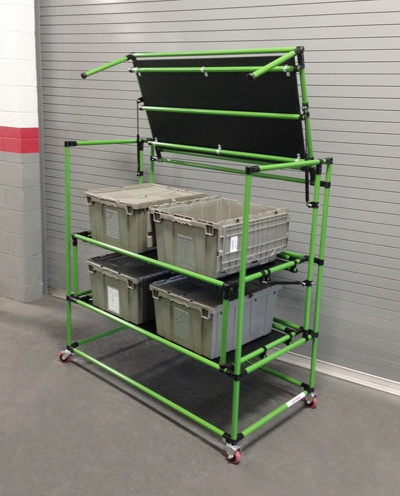
Creform Corp. has developed a drawbridge shelf cart that is ideally suited for protecting and delivering totes, containers or unpackaged parts from warehouse to sequential operations in production. The key to the tilt-up feature of these drawbridge carts is the incorporation of gas struts similar to those found on SUV hatchbacks. The gas struts help control the speed of raising and lowering by counterbalancing the weight of each tilt-away shelf. The clearance between its shelves provides easy container or part removal thanks to the tilt-up shelves. Tightening up the space between shelves allows for additional levels in the cart and better use of space. When used for over the road transport the shelves can be designed to "sandwich" the components keeping them secure.
The use of the Creform pipe and joint system with its wide selection of accessories permits using a variety of surface materials such as wood, plastic or metal for shelving. Plus, the shelves can be enhanced with foam dunnage or shadowboards for part protection and organization.
These carts are being successfully used in aerospace for assembly and rebuilt applications and the automotive industry for synchronized inventory presentation including kitted parts. They are well suited for supplier-to-assembly plant shipping and in-plant warehouse/supermarket to line side delivery.
The cart shown has a 34" x 70" footprint designed to hold up to 600 lb (272 kg) but can easily built to other sizes. Its four 4" diameter urethane casters, two fixed and two with brakes, provide for easy, stable rolling and secure positioning. It can also be fitted with a towing tongue for tugger or AGV delivery.
The cart shown uses Creform metal joints and apple green pipe but a wide variety of pipe colors is also available including ESD for anti-static applications. Metal joints allow for easy modification and height adjustments when required. It is also available in kit form or fully assembled.
Contact Details
Related Glossary Terms
- clearance
clearance
Space provided behind a tool’s land or relief to prevent rubbing and subsequent premature deterioration of the tool. See land; relief.
- counterbalancing
counterbalancing
Use of weights or mechanisms to balance a workpiece, grinding wheel, rotating tool or other device. Minimizes machining vibration and maximizes cutting force.






